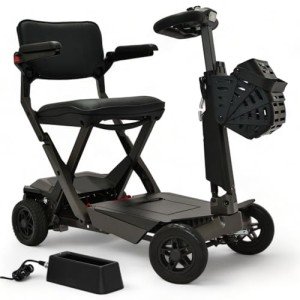ForestGay
ForestGay发表的博客
Portable Mobility Scooters: Enhancing Independence and Mobility for All
In today's hectic world, mobility is vital for leading an active and satisfying life. For people with mobility challenges, portable mobility scooters have actually become a popular and practical option. These scooters allow users to move with ease while maintaining their self-reliance. This article checks out the benefits, functions, types, and considerations surrounding portable mobility scooters, aiming to offer readers with detailed insights into this important mode of transportation.
What Are Portable Mobility Scooters?
Portable mobility scooters are compact and lightweight electric scooters developed to assist those with minimal mobility. They are usually battery-powered, making them an environmentally friendly and hassle-free way to browse different surfaces, both inside and outdoors. The design of these scooters makes sure that they can be quickly transported in lorries, making them perfect for travel and daily trips.
Key Features of Portable Mobility Scooters
Portable mobility scooters come geared up with numerous functions that improve their use and comfort. These features frequently include:
- Lightweight Construction: Many models are constructed from lightweight products, making them easy to raise and transport.
- Folding Motability Scooter Mechanism: Some scooters can be folded for further density, streamlining storage and transportation.
- Adjustable Seats: Seat height and width adjustments accommodate various user requirements, supplying comfort and support.
- Delight Stick Control: A user friendly control system guarantees riders can navigate easily.
- Adjustable Speed Settings: Many scooters permit users to manage their speed, supplying flexibility for various environments.
- Battery Range: Most portable scooters can travel a specific range on a single charge, usually varying from 10 to 20 miles, depending on the model.
Types of Portable Mobility Scooters
Portable mobility scooters can be categorized into different classes based upon their design and meant usage. Here are some typical types:
- Three-Wheeled Scooters: These scooters often have a tighter turning radius, making them perfect for indoor usage or in confined spaces.
- Four-Wheeled Scooters: More stable than three-wheeled scooters, these are fit for outside use and rougher terrains.
- Folding Scooters: These scooters can be folded down for ultra-portability, making them perfect for flight or mass transit.
- Durable Scooters: Designed for users needing higher weight capabilities, these scooters are robust and efficient in managing more requiring surfaces.
| Kind of Scooter | Features | Use Case |
|---|---|---|
| Three-Wheeled | Compact, quick maneuverability | Indoor areas, tight environments |
| Four-Wheeled | Stability, greater capacity | Outside surface, longer ranges |
| Folding | Ultra-portable, easy storage | Taking a trip, mass transit |
| Heavy-Duty | Higher weight limits, robust construct | Users needing extra support, rough terrains |
Advantages of Using Portable Mobility Scooters
The advantages of utilizing portable mobility scooters are numerous. Here are some crucial benefits:
- Increased Independence: Users can browse their environments freely without support, causing greater self-confidence and self Efficacy.
- Boosted Mobility: Mobility scooters enable users to travel longer distances than strolling would permit, opening doors to social activities, shopping, and travel.
- Health Benefits: By providing a method of mobility, these scooters encourage users to engage more actively in their communities.
- Convenience: Many portable scooters can be easily carried, allowing users to bring their mobility help anywhere they go.
- Cost-Effective: Compared to other mobility aids, portable mobility scooters often represent a more inexpensive long-lasting investment for people who need mobility support.
Factors to consider When Choosing a Portable Mobility Scooter
When picking a portable mobility scooter, individuals must think about numerous aspects to ensure they discover the very best choice for their requirements:
- Weight Capacity: Evaluate the weight limit of the scooter to guarantee it satisfies user requirements.
- Battery Life: Consider the range the scooter can travel on a complete charge, matching it to the user's common journey lengths.
- Convenience: Look for scooters with adjustable seats and armrests to promote convenience during usage.
- Terrain Compatibility: Ensure that the scooter appropriates for the environments where it will be used.
- Mobility: Assess how easily the scooter can be carried, considering its weight and folding features.
- Cost: Compare prices and offered funding options to find a scooter that fits within spending plan restrictions.
Frequently Asked Questions About Portable Mobility Scooters
1. How quick can a portable mobility scooter go?Most portable mobility scooters can reach speeds of as much as 4 to 8 miles per hour, depending on the model and type. 2. Are portable mobility scooters safe to use?Yes,
when utilized properly, portable mobility scooters are safe. Users
are recommended to follow standards and preventative measures, such as staying within weight limits and being cautious on inclines. 3. Can portable mobility scooters be used indoors?Absolutely! Numerous models are particularly developed for indoor usage
and have features that facilitate easy navigation in tight areas. 4
. Do portable mobility scooters need a license?Generally, no license is needed to run a mobility scooter; however, regulations may differ by location, so it
's smart to validate local laws. 5. How do I keep my portable mobility scooter?Basic maintenance includes routine charging of the battery, guaranteeing tire pressure is proper, and looking for any wear or damage to the scooter.
Portable mobility scooters represent a substantial development in boosting the quality of life for individuals with mobility obstacles. By using independence, improving mobility, and offering convenience, these scooters are essential tools for many. By understanding the offered choices, functions, and considerations, users can make educated decisions that best suit their lifestyles and needs, empowering them to navigate their world with confidence and ease.
